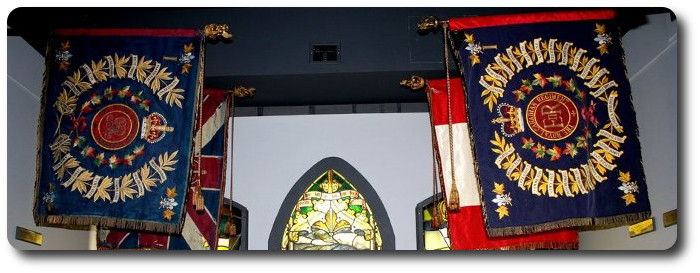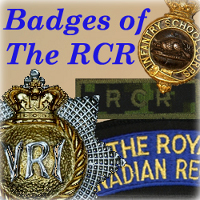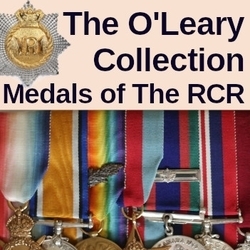
Researching The Royal Canadian Regiment
Training for Korea, Part 1
Major S.G. (Sam) Mackness, CD
The Connecting File; Issue No. 47, Dec 1981)
Major S.G. (Sam) Mackness, CD (Retd) kindly provided a brief review of the training difficulties encountered during the Korean mobilization period in 1950/51. No doubt prompted by reading previous personal recollections of the Korean conflict, he has set aside the story of the glory in battle and has truly touched upon a subject not often considered when forces are formed to enter combat. It is a tribute to those few officers and men, with few aids and resources that Major Sam has penned for your interest and benefit.
The first part takes us to the arrival in the training sites in Japan. The second part dealing with the Japanese environment, will be published in the April issue of Pro Patria.
A Training Level Recall of 2 RCR Mobilization for Korea
The final weekly intake of militia units for normal summer training had been completed at Camp Petawawa in August, 1950 and Col Peter Bingham had completed his last rendition of a bird's eye view of the famous fire power demonstration. Administration and Training (A&T) Officers who were the "training aids" for this demonstration of WWII fire power, had already packed their bags and were returning home. It was to be a brief home coming, however. On their arrival, they were greeted with a telegram to return immediately from whence they came.
The scene at Petawawa had now drastically changed. Mobilization for a fresh infantry battalion was in effect. The Camp was swarming with young, and not so young, men in various types of military and civilian dress. Most had been officially inducted, but some had mysteriously wandered in on speculation and were mixing freely with the troops.
After several days of muster parade confirmation, the recruits were organized into groups of one hundred. The obvious undesirables were escorted to the camp gate and bid farewell.
During this time, Colonel Bingham, Commander 1 RCR had been given the "simple" task of "sorting them out". "Them" was to be known as 2 RCR. Directives stated that they must be basically trained to war establishment in three months. Such a task would be formidable even with an establishment of training leaders. General Chris Volkes solved this problem for Peter by directing that junior and senior leadership would be provided from his battalion. A lesser CO might have been tempted to select the weaker links of his battalion. This was not done and 2 RCR acquired instant leadership from the best of 1 RCR. This was an example of putting regimental priorities first.
Colonel Bingham called a meeting of A&T officers and key officers of his battalion. His immediate plan was:
a. Provide an administration HQ directed by Captain Tommy Hayes, then A/Adjt 1 RCR, who would organize personnel administration and accommodation, based on a battalion other rank establishment.
b. Officer training for former WWII officers and newly appointed subalterns would be conducted by the late Colonel Chuck Lithgow, then 2IC of 1 RCR.
c. Basic training for some 700 recruits would be conducted by Sam Mackness.
The personnel and administration problem~ during the first month were monumental. Tommy Hayes and his small staff were experiencing a 16 hour day. The humorous but sometimes serious incidents among new recruits are legion. Unofficial patriots, such as "bottle men" and "skid row" candidates infiltrated the ranks. They ate, slept and drank for some days before being weeded out.
The size of orders parades, in an attempt to establish routine discipline became ridiculous. The newly appointed RSM of 2 RCR, Rocky McManus, solved this problem. He suggested that NCO's depart from normal procedures and administer discipline unofficially in the time honoured tradition. In a relatively short time, the trained NCOs and WOs from 1 RCR had the desired effect with the consequence that orders parades were drastically reduced.
Officer training under Chuck Lithgow proceeded in a conventional manner. It was some time, however, before Chuck convinced ex WWII officers that refresher training was necessary. The traditional resentment of militia officers being placed under command of permanent force officers surfaced from time to time. In due course and with Chuck's sensible training programme, the training was accepted in good part. By December, 1950 they were ready to take command of platoons and companies.
During this time, Sam Mackness had organized the A&T officers into six company training headquarters. Officers, such as Dick Couche, Jimmy Wilkinson, Fred Vine, Jock MacCrossan and Paddy Ryle, headed company training groups. Their task was to conduct basic training during the day and each evening administer personnel problems and discipline for three or four hours. This was coordinated by Tommy Hayes, who had been appointed Adjutant of the other rank mobilization.
Colonel Peter's orders to Sam Mackness were brief and concise. Each recruit must be basically trained in eight weeks. They must fire each rifle company weapon three times and be trained in section tactics. Sam questioned the feasibility of such a task. The reply was: "Sam, get on with it." It appeared at the time that further discussion would be unproductive. A training "sausage machine" seemed to be the only solution to the problem. Six companies of raw recruits had to be lifted to six training areas at seven thirty each day. A marquee was provided for each company training HQ. Rations, ammunition, training aids, etc., were dumped daily at locations along the north and south highway through Camp Petawawa. The programme functioned successfully only by the leadership provided by 1 RCR WOs and NCOs and the experience and leadership of the A&T officers. The first casualties suffered by 2 RCR occurred from a mortar explosion during this training.
In December, 1950 the aims of Colonel Bingham's training programme were realized. Officer training had been completed. The late Colonel Bob Keene had assumed Command of 2 RCR from Colonel Bingham. Chuck Lithgow had assumed the appointment of 2IC. Company and platoon commanders were with their respective companies and platoons.
At the conclusion of basic training, Sam Mackness was directed to organize a platoon live firing exercise in the gully at Petawawa. He directed each platoon through an advance to contact exercise. The battalion was now "officially" trained to platoon level.
As the last platoon completed its live firing exercise, Colonel Bob Keene tapped Sam Mackness on the shoulder and said, "You are now a member of 2nd Battalion" .He directed him to proceed to Fort Lewis, Washington, and prepare training areas and a programme of company training for use when the battalion arrived at Fort Lewis. Shortly after the battalion arrived, it was realized that there was no back-up of trained NCOs to follow the 1 RCR NCOs provided by 1 RCR. Sam Mackness was then directed to report to 25 Bde HQ. On arrival, he was instructed to establish a junior NCO course for 2 RCR and 2 R22eR. This was done with instructors from both battalions. The training was completed in six weeks and 250 junior leaders were qualified, including 100 for 2 RCR.
Brigadier Rockingham, 25 Bde Commander, directed that an NCO "Passing-Off Parade" be conducted. He invited senior American Army officers to attend. Four platoons of 2 RCR and RR22eR marched past to their regimental marches. Our American cousins seemed to be impressed when they were informed that the candidates had only four months service.
During 'this time, 2 RCR had completed company, battalion and brigade exercises at Fort Lewis. They were now preparing to sail for Korea and the prospect of immediate action on landing. However, reverse order training for 2 RCR was not yet complete. Other rank re-enforcements for 2 RCR and 2 R22eR were now arriving at 25 Canadian Reinforcement Group (25 CRG) based in Kure, Japan. It became apparent that they had been hastily trained in Canada and suffered from the long lay-off enroute to Japan. They had to be kept active during their stay and were to be introduced to field training in aground area similar to Korea, since on arrival in Korea, they would move straight into the line without further preparation.
Colonel Gordon Corbould, who was later to Command 2 RCR in Korea, Canada and Germany, was then CO of 25 CRG. He directed that Stan MacDonald and Sam Mackness establish a training camp in Central Honshu island. The location was on the edge of a mountainous area near the little town of Nippon Bara. The camp was an open area at the base of the mountains, devoid of any accommodation facilities for training and adjacent to the village.


